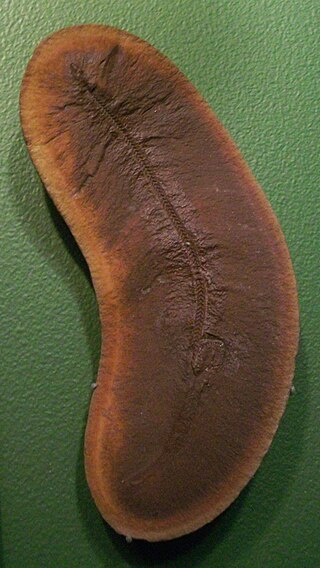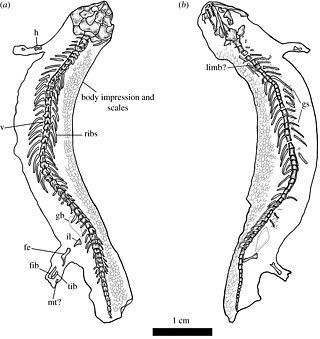
Mazon is a village in Mazon Township, Grundy County, Illinois, United States. The name derives from the Potawatomi word for "nettles" (mzan). The population was 1,015 at the 2010 census. The center of population of Illinois is located in Mazon. Illinois' State Fossil, the unique and bizarre Tully Monster was first found in nearby Mazon Creek. Mazon was formerly served by the Santa Fe railway at the Mazon Depot. It was established in 1876. The School System in Mazon was founded in the late 1800s. There was a grade school and high school that taught the kids jn Mazon-Verona-Kinsman. The MVK High School in Mazon closed and was annexed into Seneca in 1990. Today the MVK Middle School hosts grade K-8 and the team mascot is named the “Mavericks”.

Tullimonstrum, colloquially known as the Tully monster or sometimes Tully's monster, is an extinct genus of soft-bodied bilaterian animal that lived in shallow tropical coastal waters of muddy estuaries during the Pennsylvanian geological period, about 300 million years ago. A single species, T. gregarium, is known. Examples of Tullimonstrum have been found only in the Essex biota, a smaller section of the Mazon Creek fossil beds of Illinois, United States. Its classification has been the subject of controversy, and interpretations of the fossil have likened it to molluscs, arthropods, conodonts, worms, tunicates, and vertebrates. This creature had a mostly cigar shaped body, with a triangular tail fin, two long stalked eyes, and a proboscis tipped with a mouth-like appendage. Based on the fossils, it seems this creature was a nektonic carnivore that hunted in the ocean’s water column. When Tullimonstrum was alive, Illinois was a mixture of ecosystems like muddy estuaries, marine environments, and rivers and lakes. Fossils of other organisms like crustacean Belotelson, the cnidarian Essexella, and the elasmobranch fish Bandringa have been found alongside Tullimonstrum.
The Mazon Creek fossil beds are a conservation lagerstätte found near Morris, in Grundy County, Illinois. The fossils are preserved in ironstone concretions, formed approximately 309 million years ago in the mid-Pennsylvanian epoch of the Carboniferous period. These concretions frequently preserve both hard and soft tissues of animal and plant materials, as well as many soft-bodied organisms that do not normally fossilize. The quality, quantity and diversity of fossils in the area, known since the mid-nineteenth century, make the Mazon Creek lagerstätte important to paleontologists attempting to reconstruct the paleoecology of the sites. The locality was declared a National Historic Landmark in 1997.
The Mazon River or Mazon Creek, is a tributary of the Illinois River in the United States. The confluence is near Morris, Illinois.
Euphoberia is an extinct genus of millipede from the Pennsylvanian epoch of the Late Carboniferous, measuring up to 15 centimetres (5.9 in) in length, that is small in Euphoberiidae which contains species with length about 30 centimetres (12 in). Fossils have been found in Europe and North America.
Pohlsepia mazonensis is a species of fossil organism with unknown affinity. Although it was originally identified as an extinct cephalopod, later studies denied that interpretation. The species is known from a single exceptionally preserved fossil discovered in the late Carboniferous (Pennsylvanian) Francis Creek Shale of the Carbondale Formation, north-east Illinois, United States.

Helenodora is an extinct basal onychophoran or lobopodian genus known from the Carboniferous Carbondale Formation of Illinois. The only known species described is H. inopinata. The ecology of this animal is not well known, but it is thought that it may have lived on land and/or underwater.

Latzelia is an extinct genus of scutigeromorph centipedes, and the type and only genus of the family Latzeliidae. It existed during the Carboniferous in what is now Illinois. It was described by Samuel Hubbard Scudder in 1890, and the type species, and only known species, is Latzelia primordialis. The genus name honors Austrian zoologist Robert Latzel.

Pseudophlegethontia is an extinct genus of aïstopod stegocephalians. It is the only member of the family Pseudophlegethontiidae. The only species is the type species P. turnbullorum, named in 2003. Fossils of Pseudophlegethontia have been found from the Mazon Creek fossil beds in Grundy County, Illinois, a conservation lagerstätte well known for the exceptional preservation of middle Pennsylvanian taxa.
Illiniichthys is an extinct genus of prehistoric bony fish that lived during the late Moscovian stage of the Pennsylvanian epoch in what is now Illinois, United States. Fossils were collected from the Mazon Creek fossil beds. The genus is named after the Illini Native American tribe.
Nozamichthys is an extinct genus of prehistoric bony fish that lived during the late Moscovian stage of the Pennsylvanian epoch in what is now Illinois, United States. Fossils were collected from the Mazon Creek fossil beds. The first part of the genus name is Mazon spelled backwards, and the second part means 'fish'.
Palenarthrus is an extinct genus of scolopendromorph centipedes. It existed during the Carboniferous in what is now Illinois. This genus is known from single poorly preserved specimen, which is not informative expect that is likely to be a scolopendromorph.
Paleocadmus is a genus of radula known only from the Mazon Creek biota. It is only known from isolated fossils around a centimetre in length, and a few mm wide, but its morphology aligns it with the nautiloids, or perhaps the bactritoids or belemnoids.

Paleontology in Illinois refers to paleontological research occurring within or conducted by people from the U.S. state of Illinois. Scientists have found that Illinois was covered by a sea during the Paleozoic Era. Over time this sea was inhabited by animals including brachiopods, clams, corals, crinoids, sea snails, sponges, and trilobites.

Essexella is an extinct genus of cnidarian known from Late Carboniferous fossils; it contains a single species, E. asherae. It is one of the most recurrent organisms in the Mazon Creek fossil beds of Illinois; in the Essex biota of Mazon Creek, it consists of 42% of all fossil finds. Essexella was originally described as a jellyfish, but was recently redescribed as a sea anemone. The scientists on the "anemone" side of the debate made a book as early as 2017, but it was ignored until the same authors made a proper scientific paper in 2023.
Infernovenator is a genus of Carboniferous lysorophian recumbirostran from the Mazon Creek lagerstätte in Illinois, U.S. It was described in 2019.

Bandringa is an extinct genus of elasmobranch known from the Pennsylvanian subperiod of the Carboniferous period that was part of the monotypic family Bandringidae. There is currently a single known species, B. rayi, described in 1969. It is known from exceptionally preserved individuals found in the Mazon Creek Lagerstätte of Illinois which dates back to the late Moscovian stage.

Joermungandr is an extinct genus of recumbirostran tetrapod from the Late Carboniferous Mazon Creek fossil beds of Illinois. It currently contains a single species, Joermungandr bolti. Like many other recumbirostrans, the body is elongated, which is likely an adaptation for fossoriality.
Carbotubulus is a genus of extinct worm belonging to the group Lobopodia and known from the Carboniferous Carbondale Formation of the Mazon Creek area in Illinois, US. A monotypic genus, it contains one species Carbotubulus waloszeki. It was discovered and described by Joachim T. Haug, Georg Mayer, Carolin Haug, and Derek E.G. Briggs in 2012. With an age of about 300 million years, it is the first long-legged lobopodian discovered after the period of Cambrian explosion.

Weygoldtina is an extinct genus of tailless whip scorpion known from Carboniferous period, and the only known member of the family Weygoldtinidae. It is known from two species described from North America and England and originally described in the genus Graeophonus, which is now considered a nomen dubium.










